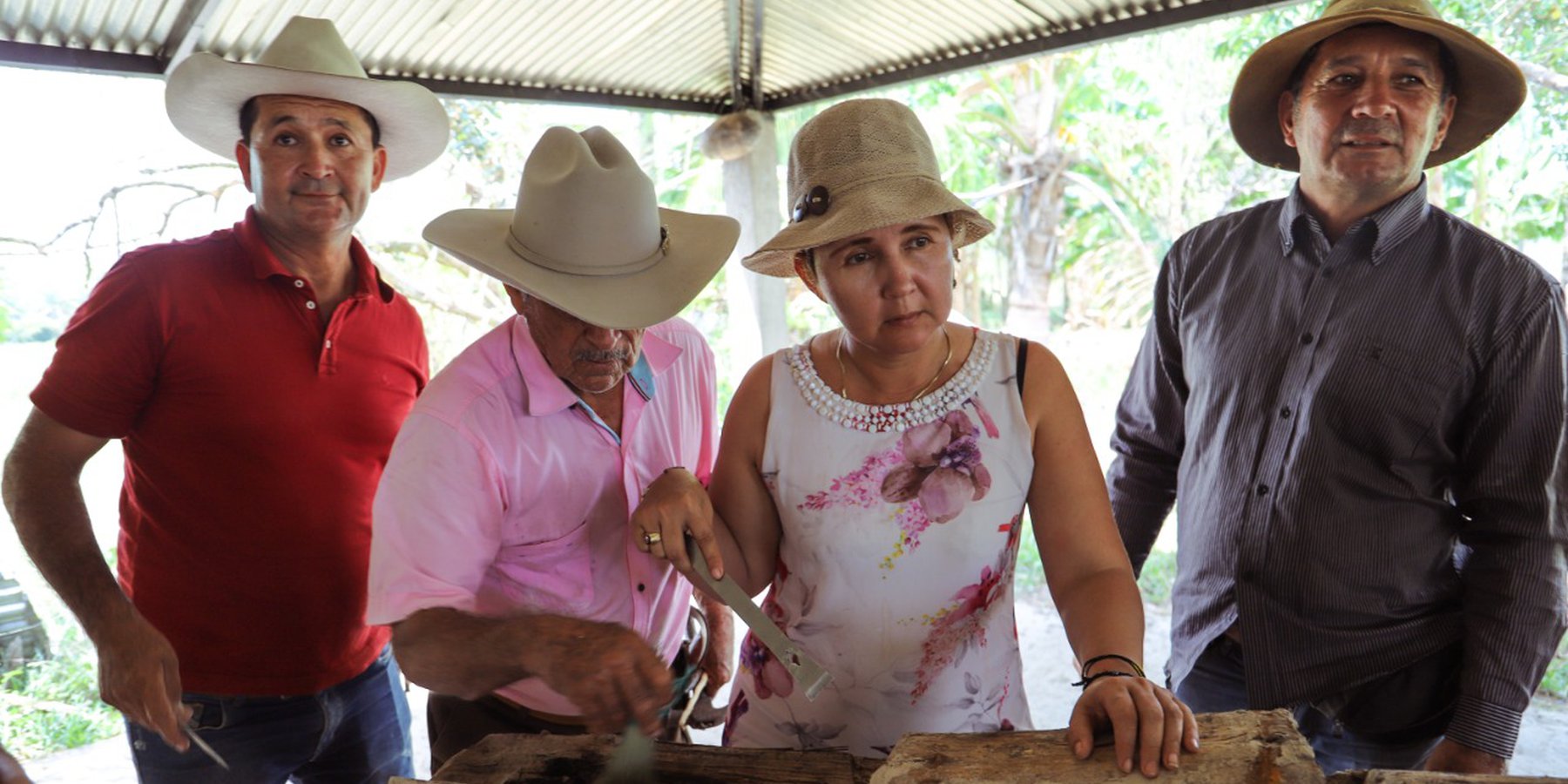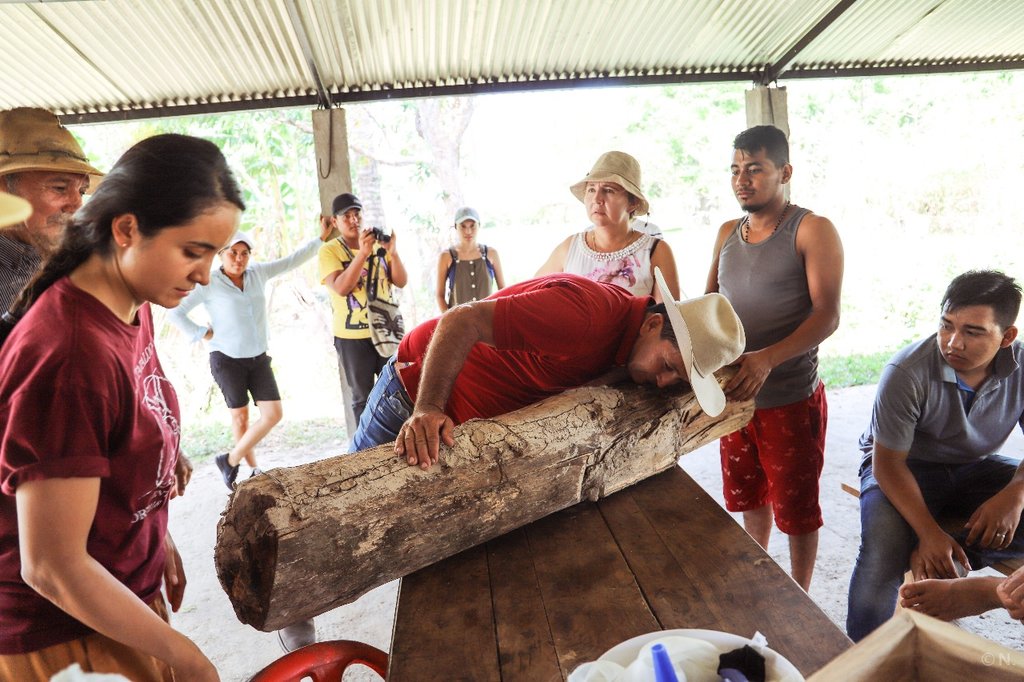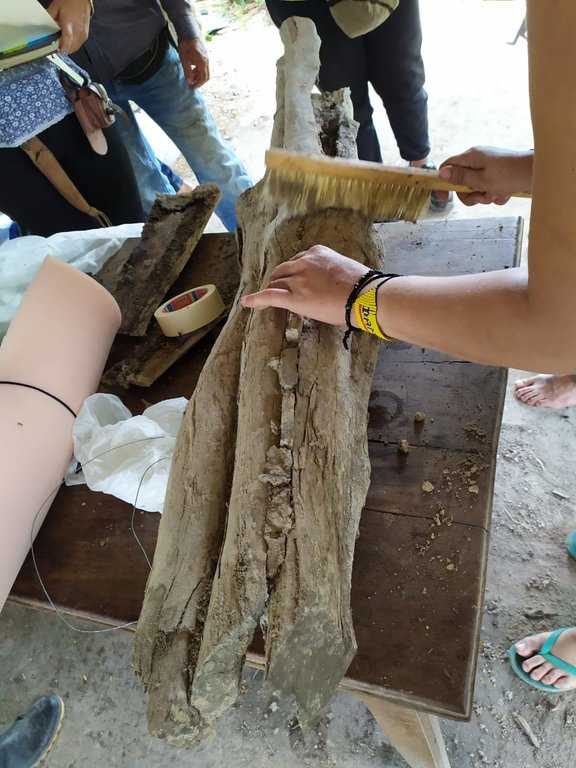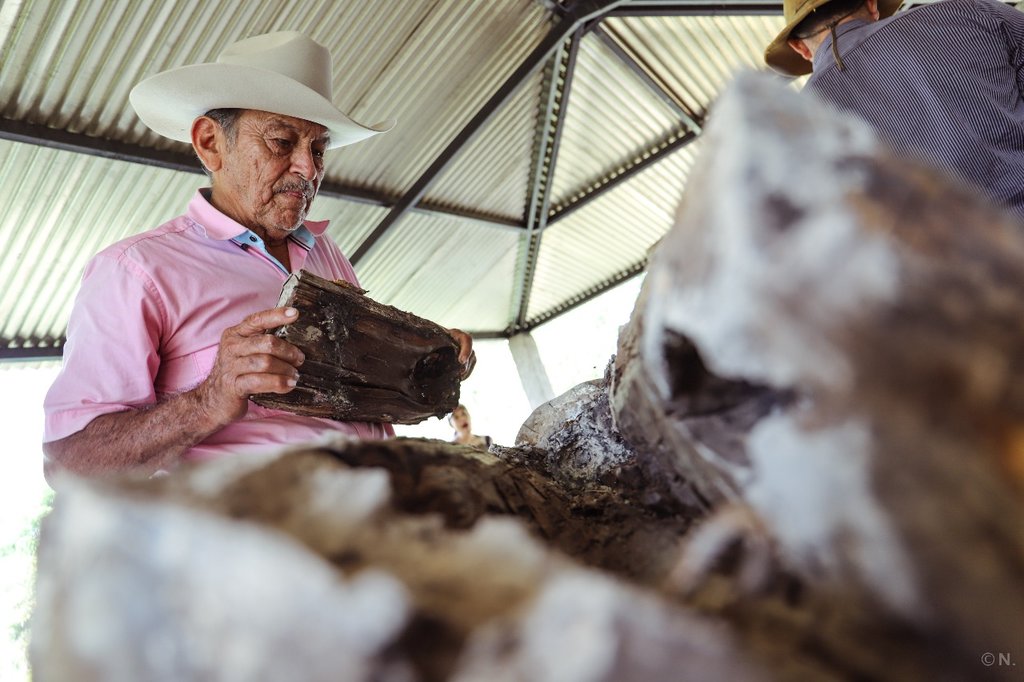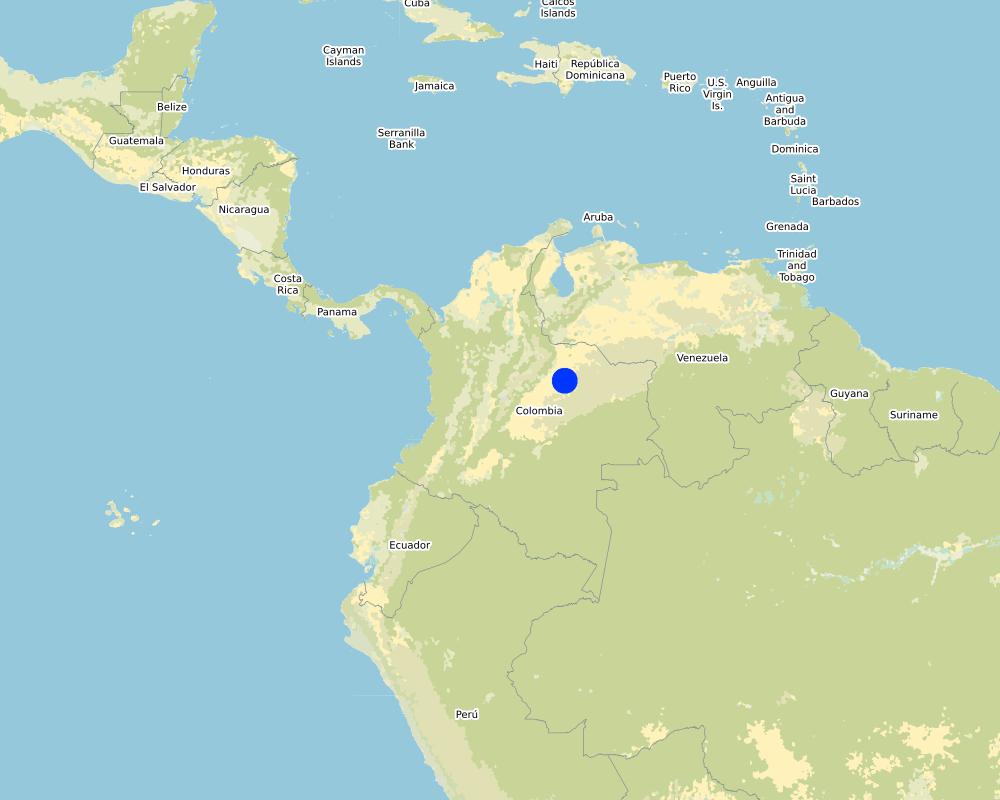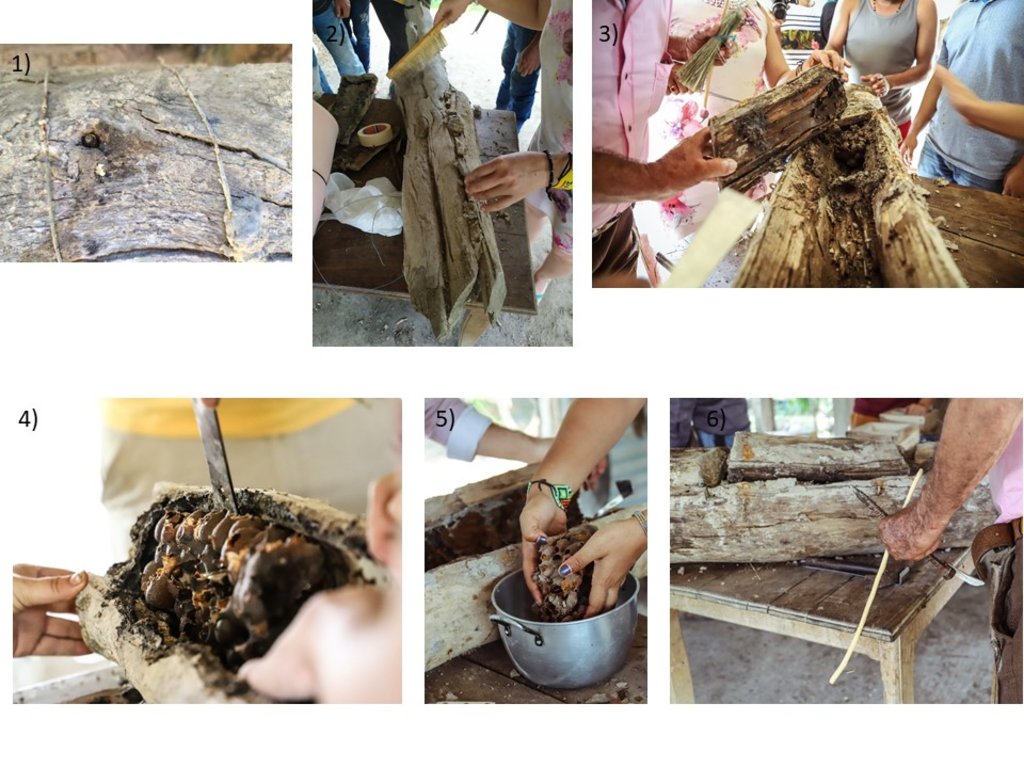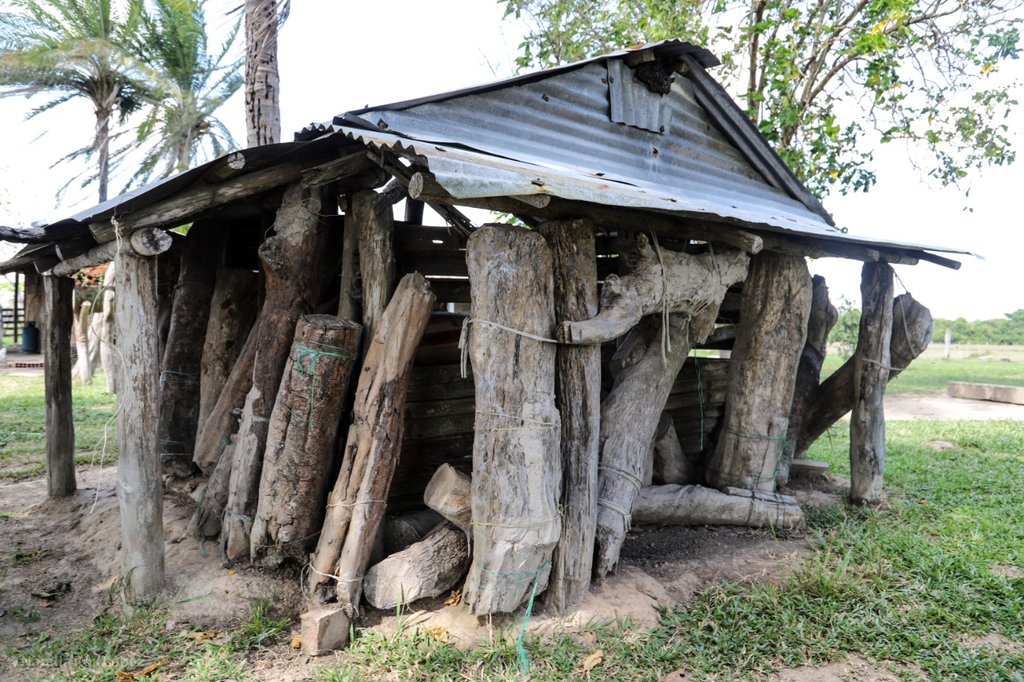Sustainable traditional native bee (Melipona favosa) keeping [Колоумб]
- Шинийг нээх:
- Шинэчлэх:
- Эмхэтгэгч: Beatriz Ramirez
- Хянан тохиолдуулагч: Luisa F. Vega
- Хянагч: Hanspeter Liniger
Cría de abeja mancita
technologies_5797 - Колоумб
Бүлгүүдийг үзэх
Бүгдийг дэлгэх Бүгдийг хаах1. Ерөнхий мэдээлэл
1.2 Технологийг үнэлэх, баримтжуулах ажилд хамаарах мэдээлэл өгсөн хүмүүс, байгууллагуудын холбоо барих мэдээлэл
Мэдээлэл өгсөн хүн (с)
Газар ашиглагч:
Abril Héctor
Finca La Reforma
Колоумб
Газар ашиглагч:
Abril Héctor Frugo
Finca La Corocora
Колоумб
Газар ашиглагч:
Abril Damaris
Finca La Esmeralda
Колоумб
Газар ашиглагч:
Abril Boncieth
Finca Arbolitos
Колоумб
Газар ашиглагч:
Abril Héctor Daniel
Finca La Berraquera
Колоумб
Технологи баримтжуулах/үнэлэх ажилд дэмжлэг үзүүлсэн байгууллага(ууд)-ын нэр (шаардлагатай бол)
Centro de Estudios Ambientales de la Orinoquia- Asociación de Becarios de Casanare (ABC) - Колоумб1.3 ВОКАТ-аар баримтжуулсан өгөгдлийг ашиглахтай холбоотой нөхцөл
Эмхэтгэгч болон гол мэдээлэгч хүн(хүмүүс) WOCAT аргачлалаар баримтжуулсан мэдээллийг ашиглахтай холбоотой нөхцлийг хүлээн зөвшөөрсөн:
Тийм
1.4 Технологи тогтвортой гэдгийг баталгаажуулах
Энэ технологийг газрын доройтлыг бууруулж, газрын тогтвортой менежментийг хангахад тохиромжтой гэж үзэж болох уу?
Үгүй
2. ГТМ Технологийн тодорхойлолт
2.1 Технологийн товч тодорхойлолт
Технологийн тодорхойлолт:
Native stingless bee keeping (Melipona favosa) protects bees and plants found in forest and savannah ecosystems to produce honey. In contrast to current destructive wild bee honey harvesting, members of the Abril family keep the traditional practice of capturing/rescuing wild nests, and adapt them so that honey can be extracted from the same nest for many years (up to 30 y) without killing the bees.
2.2 Технологийн дэлгэрэнгүй тодорхойлолт
Тодорхойлолт:
Native bee honey production in the floodable savannahs of the eastern Colombian Llanos (Orinoco River Basin), relies on stingless bees of the species Melipona favosa. These bees nest inside tree trunks. The main characteristics of the native bee keeping, as currently performed by three generations of the Abril Family, is that it is sustainable, promotes de conservation of native ecosystems, and as far as we know, constitutes the only sustainable and profitable direct use of local biodiversity in the floodable savannahs of the eastern Llanos in Colombia. Its sustainability is due to the adaptations and management of the nests, so that honey can be extracted without damaging the bees. On one hand, they know how to retrieve wild nests, either by rescuing them from rotten trees or the ground, or by cutting the branch with the nest, and then keeping its natural position at all times. Once at their houses, they will study the outside of the nest and listen to the bees inside the nest, with this information they will cut out a part of the tree trunk to create a window. Once opened, they verify the location of the honey and pollen pots and the broods. Then, they will reattach the cut part on to the trunk by using metal wire and sealing the edges with mud. The nest will be hanged with wire in the position it was originally found. Once on site they will check every day for the presence of the sentinel bee and bee activity. Furthermore, they only extract honey during the end of the dry season when bees have enough food reserves. For the extraction, they will reopen the previously cut window, and extract the honey and pollen pots, making sure enough are left behind so that bees can have access to food as well. The mean honey production from each nest is around the 750 ml- 1000 ml. Honey is kept for their own use and sold to some people for a fairly high price (30 dollars per 750 ml). The honey is mainly consumed as a medicinal product, and its low quantity makes it highly sought after. If someone requests it for sight issues, Héctor will extract the honey with a syringe so that it is as clear as possible.
The native bee keeping contributes to protect native bees, as the management of nests can keep them functional for up to 30 years. The Abril family members are well aware of the dependency between honey production and presence of native plants from where bees forage for nectar and pollen. Therefore, they avoid forest clearing and selectively keep shrubs in the grasslands to guarantee food supply for their bees. Also, they plant fruit trees such as guayaba (Psidium guajava) and arazá (Eugenia stipitata), that benefit the bees, which at the same time benefit pollination. Fruit production is mainly used for home use and very seldom they are sold. They also witness the negative impacts that agrochemical airborne dispersion from rice production in the neighbouring farms, have on wild bee populations. So far, their main concern is that they do not know how to multiply the nests.
2.3 Технологийн гэрэл зураг
2.4 Технологийн дүрс бичлэг
Тайлбар, товч тодорхойлолт:
They are harvesting the honey from the pots throught the window, without affecting the brooding area. https://youtu.be/ZS_TbwV3fnw
Он, сар, өдөр:
30/01/2020
Байршил:
Finca La Reforma, Vereda Los chochos, Municipality: Trinidad, Department: Casanare, Colombia
Зураглаачийн нэр:
Mildred Sossa
2.5 Энэ үнэлгээнд хамрагдсан технологийг хэрэгжүүлсэн улс орон/ бүс нутаг/ байршил
Улс:
Колоумб
Улс/аймаг/сум:
Casanare
Байршлын дэлгэрэнгүй тодорхойлолт:
Municipality: Trinidad, Vereda: Los Chochos
Технологи өргөн дэлгэрсэн эсхийг тодорхойл:
- тодорхой газар хэрэгжсэн/ жижиг талбайд төвлөрсөн
Технологи(иуд) нэвтрүүлсэн талбай тусгай хамгаалалттай газар нутагт байрладаг уу?
Үгүй
Тайлбар:
All farms are neighbors and they all belong to the Abril family members (Father, two sons and a daughter)
Map
×2.6 Хэрэгжсэн хугацаа
Байгуулсан тодорхой оныг мэдэхгүй бол баримжаа хугацааг тодорхойл:
- 10-50 жилийн өмнө
2.7 Технологийн танилцуулга
Технологийг хэрхэн нэвтрүүлснийг тодорхойл:
- Уламжлалт системийн хэсэг (> 50 жил)
Тайлбар (төслийн төрөл г.м.):
Héctor Abril, has been working with this traditional systems since more than 50 years ago. The traditional system consists in creating a window implied o extract honey without damaging the nest. This knowledge has been passed on to his sons and daughter.
3. ГТМ технологийн ангилал
3.1 Технологийн үндсэн зорилго (ууд)
- үйлдвэрлэлийг сайжруулах
- экосистемийг хамгаалах
- биологийн төрөл зүйлийг хамгаалах / сайжруулах
- үр ашигтай эдийн засгийн нөлөөг бий болгох
3.2 Технологи нэвтрүүлсэн газрын одоогийн газар ашиглалтын хэлбэр(үүд)
Нэг газр нутгийн хэмжээнд хэрэгжих холимог газар ашиглалт:
Үгүй

Бэлчээрийн газар
Бэлчээрийн мал аж ахуй:
- Ранч
Амьтдын төрөл зүйл:
- үхрийн аж ахуй - махны чиглэлийн үхэр
Тариалан-мал аж ахуйн нэгдсэн менежмент хэрэгждэг үү?
Үгүй
Бүтээгдэхүүн ба үйлчилгээ:
- мах
Төрөл зүйл:
үхрийн аж ахуй - махны чиглэлийн үхэр
Тоо хэмжээ:
150
Төрөл зүйл:
зөгийн аж ахуй, зөгий үржүүлэг
Тоо хэмжээ:
80

Байгалийн ой / модтой газар
- (Таримал) байгалийн ой/мод бүхий газар
(Сэргээсэн)байгалийн ой/тармаг ойд: Менежментийн төрлийг тодорхойлно уу:
- Сонгомол огтлол
- Ойн дагалт баялаг ашиглах
(Сайжруулсан)байгалийн ойн төрөл:
- тропикийн чийглэг, навчаа гөвдөг ойн ургамалжилт
- тропикийн сөөгт ургамалжилт
- Natural strips of gallery forest along savannah's rivers
Тайлбар:
The main economic activity of this group of farms is extensive cattle ranching on natural floodable savannhas (242 ha), but they all have bee keeping in their houses. The number 80 refers to the nest quantity. They preserve gallery forests (108 ha) and allow for fallows (28 ha) to develope near the houses for supplying nectar and pollen to the bees.
3.3 Технологи хэрэгжүүлснээр газар ашиглалтад өөрчлөлт гарсан уу?
Технологи хэрэгжүүлснээр газар ашиглалтад өөрчлөлт гарсан уу?
- Тийм (Технологи хэрэгжүүлэхээс өмнөх үеийн газар ашиглалтын талаархи асуулгыг бөглөнө үү)
Нэг газр нутгийн хэмжээнд хэрэгжих холимог газар ашиглалт:
Үгүй

Байгалийн ой / модтой газар
- (Таримал) байгалийн ой/мод бүхий газар
(Сэргээсэн)байгалийн ой/тармаг ойд: Менежментийн төрлийг тодорхойлно уу:
- Ойн дагалт баялаг ашиглах
(Сайжруулсан)байгалийн ойн төрөл:
- тропикийн чийглэг, навчаа гөвдөг ойн ургамалжилт
- тропикийн сөөгт ургамалжилт
Тайлбар:
The fact that their traditional practice allow for them to keep the bee nests in their houses for up to 30 years, means that they had to protect surrounding forests and allow for shrubland recovery nearby the house. Otherwise, they would just either collect honey directly in the field in a single destructive event or bring a couple of nests per year home and then extract honey in a destructive way.
3.4 Усан хангамж
Технологи хэрэгжүүлсэн газрын усан хангамж:
- Байгалийн усалгаатай
Тайлбар:
The farms have some windmills for water extraction for the cattle ranching, but these are not used for the natural ecosystems that sustain the bees during the dry season.
3.5 Технологи ГТМ-ийн аль бүлэгт хамаарах вэ
- Зөгийн аж ахуй, загасны аж ахуй, тахиа үржүүлэг, туулай үржүүлэг, торгоны хүүхэлдэйн аж ахуй г.м
3.6 Технологийг бүрдүүлэх ГТМ арга хэмжээ

Ургамлын арга хэмжээ
- V1: Мод ба бут, сөөг

Менежментийн арга хэмжээ
- М1: Газар ашиглалтын хэлбэрийг өөрчлөх
Тайлбар:
Bee keeping implies supplying the bees nectar and polen demands, thus, for sustaining their bees the Abril family is particularly keen on protecting their gallery forests and allow shrub regeneration. In addition, they are cultivating fruit trees (guayaba- Psidium guajava; arazá- Eugenia stipitata) near the houses, impplying a change in land cover from grazing land to fruit crops.
3.7 Технологид харгалзах газрын доройтлын төрөл

хөрс усаар эвдрэх
- Wt: Хөрсний гадаргын угаагдал

хөрс салхиар эвдрэх
- Et: Хөрсний гадаргын зөөгдөл

хөрсний физик доройтол
- Pc: Хөрс дагтарших

биологийн доройтол
- Bh: Амьдрах орчин доройтох
- Bs: Ургамлын чанар, төрөл зүйл, олон янз байдал буурах
Тайлбар:
Forest conservation and shrub recovery and fruit crops aid in the reduction of erosion by water during the wet season, and erosion by wind during the dry season. Forest conservation and shrub recovery and fruit crops reduce areas exposed to cattle trampling. Forest conservation, shrub recovery and fruit crops are likely important to protect soil fauna, to enhance the survival of bees and many other animal and plant species. A high density of pollinators is also important for natural vegetation and fruitting crop
3.8 Газрын доройтлоос урьдчилан сэргийлэх, сааруулах ба нөхөн сэргээх
Газрын доройтолтой холбоотойгоор Технологи ямар зорилго тавьсан болохыг тодорхойл:
- газрын доройтлоос урьдчилан сэргийлэх
Тайлбар:
On the one hand, they actively preserve the riparian forests because of their awareness of the relation between bee survival and honey production with forest cover. This reduces land degradation. On the other hand, surrounding their houses where they keep the bees they have planted trees and allowed for fallow areas to offer pollen and nectar to their bees, restoring land that has been previously used for cattle ranching
4. Техникийн нөхцөл, хэрэгжүүлсэн үйл ажиллагаа, материал ба зардал
4.1 Технологийн техник зураг
Техник тодорхойлолт (техник зургийн тайлбар):
This is too complex to draw, so we presented the sequence of extracting honey in a nest that has been modified so that the nest can live up to 30 years.
Зохиогч:
Natalia Roa y Beatriz Ramírez
Он, сар, өдөр:
30/01/2020
Техник тодорхойлолт (техник зургийн тайлбар):
This is the housing for the nests. These nests have been collected or rescued from field. The youngest has 3 years the oldest has around 30 years. It is very important to keep the nests in the position they were originally found. The housing is to prevent direct sunshine and rainfall exposition.
Зохиогч:
Natalia Roa
Он, сар, өдөр:
30/01/2020
4.2 Материал болон зардалд хамаарах ерөнхий мэдээлэл
Үнэ өртөг, оруулсан хувь нэмрийг хэрхэн тооцсоныг тодорхойл:
- Технологийн нэгж тус бүр
Нэгжийг тодорхойл:
bee nest
Үнэ өртөгийг тооцоход ашигласан мөнгөн нэгж:
- Ам.доллар
Хөлсний ажилчны нэг өдрийн цалингийн хэмжээг тодорхойлно уу:
$ 15
4.3 Бий болгох үйл ажиллагаа
| Үйл ажиллагаа | Хугацаа (улирал) | |
|---|---|---|
| 1. | Wild nest recue or extraction and transport to the house | Depends on the finding, but it is preferred in the dry season where more floral resources are available |
| 2. | Opening of a window in the nest | A couple of days after being collected/recued |
| 3. | Locating the nest under housing | Just after the window opening |
4.4 Бий болгоход шаардагдсан зардал, хөрөнгийн өртөг
| Зардлын нэр, төрөл | Хэмжих нэгж | Тоо хэмжээ | Нэгжийн үнэ | Зардал бүрийн нийт өртөг | Нийт дүнгээс газар ашиглагчийн төлсөн % | |
|---|---|---|---|---|---|---|
| Хөдөлмөр эрхлэлт | Two people for wild nest recue or extraction and transport to the house | day | 2.0 | 15.0 | 30.0 | 100.0 |
| Хөдөлмөр эрхлэлт | Opening of a window in the nest | day | 0.5 | 15.0 | 7.5 | 100.0 |
| Хөдөлмөр эрхлэлт | Housing construction (two people) | day | 2.0 | 15.0 | 30.0 | 100.0 |
| Хөдөлмөр эрхлэлт | 100.0 | |||||
| Тоног төхөөрөмж | Saw | unit | 1.0 | 20.0 | 20.0 | 100.0 |
| Тоног төхөөрөмж | Chissel | unit | 1.0 | 10.0 | 10.0 | 100.0 |
| Тоног төхөөрөмж | hammer | unit | 1.0 | 8.0 | 8.0 | 100.0 |
| Тоног төхөөрөмж | Metal wire | kilo | 0.5 | 11.0 | 5.5 | 100.0 |
| Тоног төхөөрөмж | Ax | unit | 1.0 | 20.0 | 20.0 | 100.0 |
| Барилгын материал | boles minimum 15 cm diamater and 2 m of height | boles | 4.0 | 8.0 | 32.0 | 100.0 |
| Барилгын материал | wood support 4 m long | unit | 4.0 | 6.0 | 24.0 | 100.0 |
| Барилгын материал | Roof laminas (3 m) | laminas | 3.0 | 18.0 | 54.0 | 100.0 |
| Барилгын материал | Nails | box | 2.0 | 9.0 | 18.0 | 100.0 |
| Технологи бий болгох нийт үнэ өртөг | 259.0 | |||||
| Технологи бий болгох нийт үнэ өртөг, ам.доллар | 259.0 | |||||
Тайлбар:
The construction of a bee nest house can hold up to 30 bee nests.
4.5 Арчилгаа/ урсгал үйл ажиллагаа
| Үйл ажиллагаа | Хугацаа/ давтамж | |
|---|---|---|
| 1. | Checking the bee nests | daily |
| 2. | Harvesting honey | yearly |
| 3. | Seedling collection | monthly |
| 4. | tree nursery care | daily |
| 5. | planting trees | monthly |
4.6 Арчилгаа/урсгал ажилд шаардагдсан зардал, хөрөнгийн өртөг (нэг жилд)
| Зардлын нэр, төрөл | Хэмжих нэгж | Тоо хэмжээ | Нэгжийн үнэ | Зардал бүрийн нийт өртөг | Нийт дүнгээс газар ашиглагчийн төлсөн % | |
|---|---|---|---|---|---|---|
| Хөдөлмөр эрхлэлт | Daily check per bee nest | day | 0.005 | 15.0 | 0.07 | 100.0 |
| Хөдөлмөр эрхлэлт | honey harvest per bee nest (2 people) | day | 1.0 | 15.0 | 15.0 | 100.0 |
| Хөдөлмөр эрхлэлт | Seedling collection | month | 2.0 | 15.0 | 30.0 | 100.0 |
| Хөдөлмөр эрхлэлт | Planting of fruitting trees | month | 2.0 | 15.0 | 30.0 | 100.0 |
| Тоног төхөөрөмж | Chissel | unit | 1.0 | 10.0 | 10.0 | 100.0 |
| Тоног төхөөрөмж | Broom | unit | 1.0 | 3.0 | 3.0 | 100.0 |
| Тоног төхөөрөмж | Hammer | unit | 1.0 | 8.0 | 8.0 | 100.0 |
| Тоног төхөөрөмж | Syringe | unit | 1.0 | 0.2 | 0.2 | 100.0 |
| Тоног төхөөрөмж | Empty glass bottles (750 ml) | unit | 70.0 | 0.4 | 28.0 | 100.0 |
| Тоног төхөөрөмж | Table | unit | 1.0 | 30.0 | 30.0 | 100.0 |
| Тоног төхөөрөмж | shovel | unit | 1.0 | 20.0 | 20.0 | 100.0 |
| таримал материал | Bags x 50 units | bag | 1.0 | 5.0 | 5.0 | 100.0 |
| таримал материал | Soil | sack | 4.0 | 6.0 | 24.0 | 100.0 |
| Технологийн арчилгаа/урсгал үйл ажиллагаанд шаардагдах нийт үнэ өртөг | 203.27 | |||||
| Технологи арчилах ба урсгал ажлын нийт үнэ өртөг, ам.доллар | 203.27 | |||||
4.7 Зардалд нөлөөлж байгаа хамгийн чухал хүчин зүйл
Өртөг, зардалд нөлөөлөх гол хүчин зүйл:
The way they manage the bee productive system is fairly cheap and most materials are already accessible within the farms.
5. Байгаль ба нийгмийн нөхцөл
5.1 Уур амьсгал
Жилийн нийлбэр хур тундас
- < 250 мм
- 251-500 мм
- 501-750 мм
- 751-1,000 мм
- 1,001-1,500 мм
- 1,501-2,000 мм
- 2,001-3,000 мм
- 3,001-4,000 мм
- > 4,000 мм
Жилийн дундаж хур тунадас (хэрэв мэдэгдэж байвал), мм:
1938.00
Хур тунадасны талаархи тодорхойлолт/ тайлбар:
highly monomodal seasonal rainfall with 4 months without rainfall (< 60 mm/ month), and 8 months with rainfall (>100 mm/ month) with June as the month with highest rainfall (> 300 mm)
Холбогдох цаг уурын станцын нэр:
Estación pluviométrica de Trinidad (IDEAM)
Агро-уур амьсгалын бүс
- чийглэг
The highly seasonal rainfall, implies four months of extreme drought and at least 6 months of flooded areas. Both severely limit crop growth.
5.2 Гадаргын хэлбэр
Дундаж налуу:
- хавтгай (0-2 %)
- бага зэрэг налуу (3-5 %)
- дунд зэрэг налуу (6-10 % )
- хэвгий (11-15 %)
- налуу (16-30 %)
- их налуу (31-60 % )
- эгц налуу (>60 %)
Гадаргын хэлбэр:
- тэгш өндөрлөг / тал
- нуруу
- уулын энгэр
- дов толгод
- бэл
- хөндий
Өндрийн бүслүүр:
- 0-100 д.т.д. м.
- 101-500 д.т.д. м.
- 501-1,000 д.т.д м.
- 1,001-1,500 д.т.д м.
- 1,501-2,000 д.т.д м.
- 2,001-2,500 д.т.д. м.
- 2,501-3,000 д.т.д. м.
- 3,001-4,000 д.т.д м.
- > 4,000 д.т.д. м.
Технологи дараах асуудалд хандсан эсэхийг тодорхойл:
- хамааралгүй
Гадаргын талаархи тодорхойлолт ба бусад тайлбар:
This is a low elevation flat area. Overall the floodable savannahs are concave but microtopography has primarily concave areas (bajos) with a lower extent of convex areas (bancos).
5.3 Хөрс
Хөрсний дундаж зузаан:
- маш нимгэн (0-20 см)
- нимгэн (21-50 см)
- дунд зэрэг зузаан (51-80 см)
- зузаан (81-120 cм)
- маш зузаан (>120 cм)
Хөрсний бүтэц (өнгөн хөрс):
- дундаж (элсэнцэр, шавранцар)
Хөрсний бүтэц (>20 см-ээс доош):
- дундаж (элсэнцэр, шавранцар)
- нарийн /хүнд (шаварлаг)
Өнгөн хөрсөнд агуулагдах ялзмаг:
- бага (<1 % )
Боломжтой бол хөрсний бүрэн тодорхойлолт, боломжит мэдээллийг өгнө үү, жишээ нь хөрсний төрөл, хөрсний урвалын орчин/хүчиллэг байдал, катион солилцох чадавхи, азотын хэмжээ, давсжилт г.м.
In the seasonally floodable savannhas there are three main soil types: 1) Clayey sediments, 2) fine and coarse alluvial sediments, and 3) lime and sand eolic deposits. Soil description is based on the 1:100.000 scale Casanare soil study, by the National Geographical Institute Agustín Codazzi.
5.4 Усны хүртээмж ба чанар
Гадаргын усны хүртээмж:
дунд зэрэг
Усны чанар (цэвэршүүлээгүй):
муу чанарын ундны ус (цэвэршүүлэх шаардлагатай)
Усны давсжилтын асуудал бий юу?
Үгүй
Энэ газар үерт автдаг уу?
Тийм
Тогтмол байдал:
байнга
Усны чанар, нөөцийн талаархи тайлбар ба бусад тодорхойлолт:
Drinking water is usually provided by ground water year round. During the wet season there is a generalized flood, and during the dry season there is severe drought. Thus, the water table level goes from surface to deeper than 9 m.
5.5 Биологийн олон янз байдал
Зүйлийн олон янз байдал:
- Их
Амьдрах орчны олон янз байдал:
- Их
Биологийн олон янз байдлын талаархи тайлбар ба бусад тодорхойлолт:
Habitats include: Gallery/riparian forest, isolated tree islands (matas de monte), seasonally flooded savannhas, wetlands.
Reported biodiversity for the seasonally floodable savannahs is: 183 spp of mammals, 507 spp of birds, 108 spp of anphibians, 119 spp of reptiles, 567 spp of fish, 1479 spp of plants (Mora-Fernández et al., 2015).
5.6 Технологи нэвтрүүлсэн газар ашиглагчдын тухай мэдээлэл
Суурьшмал эсвэл нүүдлийн:
- Суурьшмал
Үйлдвэрлэлийн системийн зах зээлийн чиг баримжаа:
- холимог (амьжиргаа ба худалдаанд)
Бусад эх үүсвэрээс олох орлого:
- Нийт орлогын 10 %-иас доош
Чинээлэг байдлын түвшин:
- ядуу
Хувь хүн эсвэл бүлэг:
- Хувь хүн / өрх
Механикжилтын түвшин:
- гар ажил
- ердийн хөсөг
Хүйс:
- эмэгтэй
- эрэгтэй
Газар ашиглагчийн нас:
- дунд нас
- ахимаг нас
Газар ашиглагчдын бусад шинж чанарыг тодорхойл:
All the land user's reported here are family members.
5.7 Газар ашиглагчийн технологи нэвтрүүлсэн газрын дундаж талбайн хэмжээ
- < 0.5 га
- 0.5-1 га
- 1-2 га
- 2-5 га
- 5-15 га
- 15-50 га
- 50-100 га
- 100-500 га
- 500-1,000 га
- 1,000-10,000 га
- > 10,000 га
Энэ талбай том, жижиг, дунд алинд хамаарах вэ (орон нутгийн нөхцөлд харгалзуулна уу)?
- бага-хэмжээний
- дунд-хэмжээний
Тайлбар:
For the area 30 ha farms are very small, whereas 200 ha is small-medium. This is considering that farms in this region of colombia have on average 700 ha.
5.8 Газар эзэмшил, газар ашиглах эрх, ус ашиглах эрх
Газар өмчлөл:
- хувь хүн, өмчийн гэрчилгээгүй
Газар ашиглах эрх:
- хувь хүн
Ус ашиглах эрх:
- хувь хүн
Газар ашиглах эрх нь уламжлалт эрхзүйн тогтолцоонд суурилсан уу?
Тийм
Тодорхойлно уу:
They are in the process of gaining rights, given the farms have been theirs for more than 50 years.
5.9 Дэд бүтэц, үйлчилгээний хүртээмж
эрүүл мэнд:
- ядуу
- дунд зэргийн
- сайн
боловсрол:
- ядуу
- дунд зэргийн
- сайн
техник зөвлөгөө:
- ядуу
- дунд зэргийн
- сайн
хөдөлмөр эрхлэлт (жишээ нь, ХАА-аас өөр):
- ядуу
- дунд зэргийн
- сайн
зах зээл:
- ядуу
- дунд зэргийн
- сайн
эрчим хүчний хангамж:
- ядуу
- дунд зэргийн
- сайн
зам тээвэр:
- ядуу
- дунд зэргийн
- сайн
усан хангамж ба ариутгал:
- ядуу
- дунд зэргийн
- сайн
санхүүгийн үйлчилгээ:
- ядуу
- дунд зэргийн
- сайн
Тайлбар:
These farms are in fairly remote area with poor access roads, there is a rural school but for the other services people have to travel for at least 2 hours by car to the closest urban center.
6. Үр нөлөө ба дүгнэлт
6.1 Технологийн талбайд үзүүлсэн нөлөө
Нийгэм-эдийн засгийн үр нөлөө
Үйлдвэрлэл
ойн дагалт баялгийн бүтээмж
Тайлбар/ тодорхой дурьдах:
Honey harvesting from collected bee nests
Орлого, зарлага
тухайн аж ахуйн орлого
Тайлбар/ тодорхой дурьдах:
Honey harvesting contributes with about 10% of farm income
орлогын олон янз эх үүсвэр
Тайлбар/ тодорхой дурьдах:
Honey harvesting is an additional income source from cattle ranching
Нийгэм-соёлын үр нөлөө
хүнсний аюулгүй байдал/ өөрийн хэрэгцээг хангах
Тайлбар/ тодорхой дурьдах:
Part of the honey and most of the fruits harvested are consumed by the land user theirself.
Экологийн үр нөлөө
Биологийн олон янз байдал: ургамал, амьтан
ашигт төрөл зүйл
Тайлбар/ тодорхой дурьдах:
The preservation of bee nests increases pollinator presence, whilst the conservation of gallery forests preserves habitats for wild bee populations.
амьдрах орчны олон янз байдал
Тайлбар/ тодорхой дурьдах:
allowing for fallows to regenerate for providing bees with resources (nectar, pollen, resins and seeds) increase habitat diversity.
Талбайд илэрсэн үр нөлөөг үнэлнэ үү (хэмжилт):
Measurements are qualitative estimates
6.2 Технологийн талбайн гадна үзүүлсэн үр нөлөө
буферлэх / шүүлтүүрийн багтаамж
Тайлбар/ тодорхой дурьдах:
Riparian forest conservation contributed to water regulation
Талбайн гадна илрэх үр нөлөөллийн үнэлгээг тайлбарлана уу (хэмжилтүүд):
Measurements are qualitative estimates
6.3 Технологийн уур амьсгалын өөрчлөлт, цаг агаарын гамшигт үзэгдэлд өртөх байдал ба эмзэг байдал (газар ашиглагчийн бодлоор)
Уур амьсгалаас хамаарах аюул (гамшиг)
Биологийн гамшиг
| Технологи түүний нөлөөг хэрхэн бууруулж байна? | |
|---|---|
| цар тахал | муу |
6.4 Өртөг ба ашгийн шинжилгээ
Бий болгох зардалтай харьцуулахад ямар ашиг өгсөн бэ (газар ашиглагчийн бодлоор)?
Богино хугацаанд эргэн төлөгдөх байдал:
бага зэрэг эерэг
Урт хугацаанд эргэн төлөгдөх байдал:
маш эерэг
Арчилгаа/урсгал зардалтай харьцуулахад ямар ашиг өгсөн бэ (газар ашиглагчийн бодлоор)?
Богино хугацаанд эргэн төлөгдөх байдал:
бага зэрэг эерэг
Урт хугацаанд эргэн төлөгдөх байдал:
маш эерэг
Тайлбар:
Honey harvesting is only possible once per year so for the short term it takes some time before retrieving income. However, once the nests are re-established at home the maintenance is fairly easy. The rareness and uniqueness of the product sells well in the local market. The external markets are not aware of such a product.
6.5 Технологи нэвтрүүлэлт
- жишээ/ туршилт
Боломжтой бол, тоогоор илэрхийл (өрхийн тоо эсвэл бүрхэх талбай):
5
Технологи нэвтрүүлсэн хүмүүсээс хэд нь өөрийн хүчээр технологийг хэрэгжүүлсэн бэ, өөрөөр хэлбэл гадны тусламж дэмжлэг авалгүйгээр?
- 91-100%
Тайлбар:
Talking with other local people we found that the traditional practice is very rare, mainly because it used to be the only source for sweeteners, but with the arrival of sugar cane and sugar, people stopped the practice, and for new generations the tradicional way is almost forgotten. This is highly menacing because when people find a wild nest they only destructively extract the honey affecting wild bee populations.
6.6 Дасан зохицох
Бий болсон өөрчлөлтөд зохицуулан технологийг өөрчилсөн үү?
Үгүй
6.7 Технологийн давуу тал/боломжууд
| Газар ашиглагчдын тодорхойлсон давуу тал/боломжууд |
|---|
| The medicinal properties attributed to the product make it highly sought after. |
| Having the nests at home, and passing on the traditional practice to new generations is very important, because they find very interesting to know about bee behaviour and pollination function for fruitting trees. |
| Costs are fairly low, and despite production is synchronized the demand of the product is higher that the production, so it is a welcome income to the family household assets. |
| Эмхэтгэгч, бусад мэдээлэл өгсөн хүмүүсийн өнцгөөс тодорхойлсон давуу тал/боломжууд |
|---|
| Their practice is non destructive and bee population is enhanced in the houses, it is very likely that bees will find new wild nesting sites. In this regard bee nests at houses are a source of individuals for wild populations, given that there are trees and forests nearby. |
| This practice and their knwoledge on bee behaviour and biology motivates people to conserve forests and trees and allow for fallows surrounding their houses. |
| Negative effects on their bee populations derived from land use change int heir surroundings and application of agrochemicals by neighboring rice crops serve as an indicator for them to know if those practices are deteriorating their environment. |
6.8 Технологийн дутагдалтай/сул тал/аюул болон тэдгээрийг хэрхэн даван туулах арга зам
| Газар ашиглагч нарын тодорхойлсон сул тал/ дутагдал/ эрсдэл | Тэдгээрийг хэрхэн даван туулах вэ? |
|---|---|
| Despite the long term survival of captured wil bee nests, they still rely on collecting wild nests. Which in time they feel are more scarcee | For them it is crucial to learn how to split their "domesticated" nests so they can increase production without depending on wild nests. |
| The expansion of rice crops in the area is a major threat | Public policy and law inforcement in aerial agrochemical application is urgent. Also, the transition from usual rice crop management to a more enrionmental management is required. |
| New generations are less likely to adopt traditional practices, endengering the persistence of this knowledge in time | The recognition of this traditional productive system is fundamental. |
| Эмхэтгэгч, бусад мэдээлэл өгсөн хүмүүсийн өнцгөөс тодорхойлсон сул тал/ дутагдал/ эрсдэл | Тэдгээрийг хэрхэн даван туулах вэ? |
|---|---|
| A one time per year harvesting of the product could potentially be increased to expand this sustainable practice | Restoration of key dietary elements surrounding their houses and an increase in connectivity with remaingin forest patches could potentially increase honey production |
| We agree that the loss of this practice is inminent if it is not protected as a cultural heritage | Knwoledge transfer to new generations and the recovery of this productive system, once "domesticated" bee nest can be divided or multiplied. |
7. Ном зүй ба холбоосууд
7.1 Мэдээлэл цуглуулсан арга/эх үүсвэр
- Хээрийн уулзалт, судалгаа
4
- Газар ашиглагчтай хийсэн ярилцлага
4
Мэдээллийг хэзээ (газар дээр нь) цуглуулсан бэ?
30/01/2020
Тайлбар:
Land-users were very pleased with the recognition of the their prodcutive systems and were very happy to contribute us to understand how it works.
7.3 Холбогдох мэдээллийн интернет холбоос
Гарчиг/ тодорхойлолт:
Diversidad de abejas sin aguijón (Hymenoptera: Meliponini) utilizadas en meliponicultura en Colombia. Nates-Parra, G. and Rosso-Londoño, J.M. (2013).
URL:
https://www.redalyc.org/pdf/3190/319029232001.pdf
7.4 Ерөнхий мэдээлэл
It is a bit too long but feasible to fill in.
Холбоос ба модулууд
Бүгдийг дэлгэх Бүгдийг хаахХолбоосууд
Холбоос байхгүй байна
Модулууд
Модуль байхгүй байна


